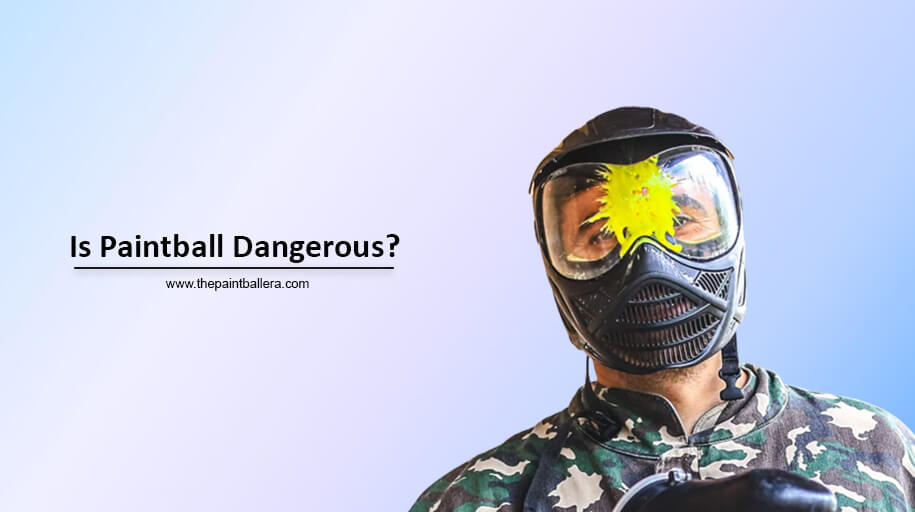Is Paintball Dangerous?

Paintball: a sport that has gained immense popularity for its adrenaline-pumping action, teamwork, and strategy. But as much as it promises excitement and camaraderie, many people wonder, “Is paintball dangerous?” It’s a legitimate concern.
After all, you’re running around with markers that shoot paint pellets at high speeds. While paintball is generally considered a safe recreational activity, especially when compared to some other extreme sports, there are risks involved that shouldn’t be brushed off.
In this blog post, we’ll delve into the various dangers associated with paintball, how to minimize those risks, and what it feels like to get hit by a paintball. Whether you’re a seasoned veteran or someone who’s been thinking about stepping onto the paintball field for the first time, this guide aims to provide a well-rounded view of the safety aspects of the game.
WHAT ARE THE DANGERS OF PAINTBALL?
When it comes to paintball, a whole spectrum of risks is involved. Before you get alarmed, remember that any sport or physical activity comes with its own dangers—think about skateboarding, cycling, or even hiking.
But knowledge is power. Understanding the risks involved can help you prepare better and minimize those dangers. So, let’s not waste more time and jump into what you need to know.
The Dangers of Paintball and How to Stay Safe
Eye and Ear Injuries
Unsurprisingly, your eyes and ears are vulnerable during a paintball match. A paintball can travel up to 300 feet per second, and if it hits you in the eye, the consequences could be severe, including permanent eye damage.
The same goes for your ears. Always wear protective goggles and helmets designed for paintball to avoid these injuries.
Concussions
While concussions are relatively rare in paintball compared to sports like football or hockey, they can still happen. A bad fall or running into an obstacle could result in a concussion. Hence, situational awareness is crucial.
Genital Injuries
Let’s be straightforward: getting hit down there is neither pleasant nor without risk. Men, mainly, can experience significant pain and injury. Protective cups are highly recommended.
Cuts
You’re running, diving, and sliding across a field with various obstacles. Cuts are bound to happen, especially if you’re playing in an area with sharp rocks or sticks. Basic first aid can handle these.
Welts and Bruises
A paintball hit can leave welts and bruises on exposed skin. These are generally more embarrassing than harmful but can still hurt a lot.
Sprained/Twisted Ankles
The terrain in paintball arenas varies; while navigating it, you might sprain or twist an ankle. Proper footwear can provide better grip and ankle support to minimize this risk.
Breathing Difficulties
You’d be surprised how many people underestimate the physical aspect of paintball. Running around with all that gear can make breathing difficult, especially for those not in the best shape.
Temporary Loss of Vision
A direct hit or splatter from a paintball can momentarily obscure your vision, especially if you’re not wearing proper eye protection. This could, in turn, put you at risk for other injuries.
Tripping
In the heat of the game, it’s easy to overlook where you’re stepping and trip over a root, rock, or even your feet.
Internal Injury
Although extremely rare, internal injuries can happen, especially if you’re hit at close range with a high-velocity paintball.
How Dangerous is Paintball?
Physical Dangers of Paintball
As you can see from the above list, paintball has its physical risks. Most of them are not life-threatening but can be painful and temporarily incapacitating.
Psychological Injuries from Paintball
Aside from the physical aspect, paintball can also be mentally demanding. The stress and anxiety of the game can be overwhelming for some players, affecting their mental health.
Smokers and Paintball
Smokers take note. Paintball requires good cardiovascular health. If you’re a smoker, you may get winded very quickly, and it might be more challenging for you to keep up with other players, thereby increasing your risk for different types of injuries.
Well, that covers some of the dangers and risks of playing paintball. But don’t be discouraged; next, we’ll discuss how to minimize these risks and still enjoy the sport you love.
Can You Be Shot to Death by a Paintball?
I know this question sounds a bit grim, but it’s one that many people—especially parents—often ask. So, let’s address this head-on: The chances of someone dying from getting shot by a paintball gun are significantly meagre.
Paintball markers are designed to be non-lethal. While they fire at high speeds, the paintballs themselves are made of a biodegradable material that breaks upon impact, lessening the force of the blow.
However, safety lapses, such as removing your mask during a game or tampering with the velocity of the paintball guns, can result in severe injuries. But these would be the exception and not the rule. The industry has safety standards for a reason, and adhering to them minimizes the risks involved.
What Does Getting Shot with a Paintball Feel Like?
Good question, especially if you’re new to the game. When a paintball hits you, you’ll probably first feel a sudden, sharp sting, almost like an intense flick or a rubber band snap. How much it hurts can depend on several factors, like the distance from which you were shot, where you were hit, and how much protective clothing you wear.
While it’s a unique feeling that’s hard to compare directly with anything else, most players agree that the anticipation is usually worse than the actual impact. The adrenaline rush you’re experiencing during the game also tends to dampen the pain. However, a close-range shot or getting hit in sensitive areas like the neck, inner thigh, or hands can be more painful.
We’ve all been there, either super excited or incredibly anxious about the first time we step onto the paintball field. Knowing what to expect can help alleviate some of that anxiety and help you prepare better, both mentally and physically.
Next, we’ll be diving into how to prevent injuries and make the paintball experience less painful. Trust me, a little prep goes a long way in ensuring you have a fantastic time while staying safe.
Preventing Paintball Injuries
So, now that we’ve discussed the potential risks let’s switch gears and discuss how to prevent these injuries. After all, an ounce of prevention is worth a pound of cure, right?
Wear the Right Gear
You wouldn’t go cycling without a helmet or swimming without knowing how to swim. Similarly, only step onto a paintball field with your essential safety gear. This includes a proper paintball mask, body armor, and neck guard.
Know the Rules
Every game has rules, and paintball is no exception. Most fields have safety briefings before each match. Pay attention! Knowing what to do and what not to do is crucial for your safety and that of others.
Physical Preparation
It may look like fun and games, but paintball is physically demanding. Essential fitness can go a long way in preventing injuries like sprains and breathlessness.
Stay Aware
Situational awareness can help you avoid obstacles and potential hazards, reducing the risk of concussions, sprains, and other injuries.
Check Your Equipment
Before you head into the game, ensure your equipment is in top condition. A malfunctioning marker or a cracked mask lens could become a safety hazard.
How to Make Paintballs Hurt Less
Ah, the golden question! No one likes the sting of a paintball hit, so how can you make it hurt less?
Layer Up, but Smartly
Wearing multiple layers can provide extra padding, reducing the impact of paintballs. But don’t overdo it—you don’t want to get overheated and dehydrated.
Choose Your Position Wisely
If you’re concerned about the pain, maybe the frontlines aren’t for you—at least not yet. Playing a supporting role allows you to maintain a safe distance from the opponents, making any hits less painful.
Use High-Quality Paintballs
Cheap paintballs can be challenging and may not break easily, increasing the pain upon impact. Investing more in good-quality paintballs can make the experience less painful for everyone involved.
Flexibility and Movement
Sometimes, it’s about more than how to take the hit and how to avoid it in the first place. Being agile and moving smartly can make you a difficult target.
Conclusion
We’ve covered a lot of ground, haven’t we? From addressing the question “Is paintball dangerous?” to exploring various types of injuries and their prevention, we’ve touched on everything you need to know to step onto the paintball field confidently.
Remember, like any other sport, paintball comes with its risks. But being informed and prepared can go a long way in ensuring a safe and enjoyable experience for everyone involved.
So next time you gear up for a paintball match, remember to suit up appropriately, be aware of your surroundings, and most importantly, have fun. With the proper precautions, the risks can be minimized, and you can focus on what’s important: enjoying the game.






